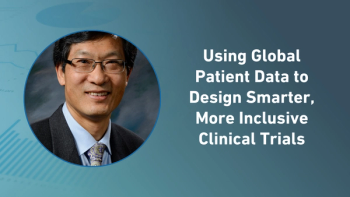
- Applied Clinical Trials-03-01-2011
- Volume 20
- Issue 3
Patient Registries and Rare Diseases
Researchers are turning to patient registries to fill rare-disease knowledge gaps.
Related Articles
1.
2.
With more than 25 million people affected in the United States—and 50 million worldwide—rare disease research and treatment is an important medical necessity. Yet, little research has been done on many rare diseases, leaving both physicians and patients with a lack of treatment options, and, in some cases, with only a basic understanding of the disease itself. New studies focusing on rare diseases often face challenges related to small patient populations, the lifelong nature of the diseases, and variations among disease sub types. Increasingly, researchers are turning to patient registries to fill some knowledge gaps, as registries offer an opportunity to learn much about the way patients are diagnosed and treated and about how they respond to various management approaches. Patient registries have considerable potential to help improve understanding of rare diseases and provide the knowledge base necessary to support development of effective treatments. >
Background
The US Food and Drug Administration (FDA) and the National Institutes of Health (NIH) define a rare or "orphan" disease as any disease that afflicts fewer than 200,000 people in the United States.1 Over 6,800 rare diseases, affecting 25 million Americans, have been identified to date. Rare diseases can cause a wide range of symptoms and may be chronic, progressive, disabling, and life-threatening. About 75 percent of these diseases affect children, and about 80 percent are related to genetic defects.2 Some of the more well-known rare diseases include sickle cell anemia, hemophilia, Tourette syndrome, and Tay-Sachs disease. Less well-known examples include Wilson's disease, Turner Syndrome, and Gaucher disease.
Research challenges
In general, little is known about most rare diseases. The small number of patients with a rare disease often results in limited clinical experience within individual treatment centers. The clinical description of the disease may be incomplete or skewed, and the medical literature often consists of individual case reports or small case series, limiting understanding of the natural history of the disease. Both the lack of available treatments and the poor understanding of many rare diseases can be linked to the unique challenges that rare disease research poses. The challenges occur across the life cycle of a research study, affecting the study design, ethical considerations, and subject recruitment and retention.
When designing a rare disease study, it may be impossible to find fundamental information on the disease on which to base the study protocol. For example, data on the disease prevalence and incidence may be unavailable, making it difficult to determine an appropriate study size. Diagnosis may be complex, particularly in cases where there is no definitive test. The development of the study data set may be hindered by a lack of information on the full range of disease symptoms or treatment practices. Selecting appropriate study durations may be difficult, particularly for diseases where new treatments are extending life spans.
Ethical concerns may also arise in rare disease research. The majority of rare diseases affect children, who are considered a vulnerable population. Designing and conducting studies that enroll children may be more complex than designing studies for adults. For example, the International Conference on Harmonization (ICH) has released detailed operational guidelines for clinical trials in pediatric populations; these guidelines recommend, for example, that studies be performed in institutions with a pediatric infrastructure and appropriate personnel. Parents may be reluctant to consent to research, and there is ongoing debate about what age assent from the child, in addition to parental consent, is necessary for participation.3 Rare disease research may also focus on other vulnerable populations, such as cognitively impaired persons or pregnant women. Rare disease studies need to be sensitive to the needs of these populations.
Once a study has begun, it may face patient recruitment challenges. By definition, rare diseases have limited patient populations. Patient recruitment can become even more complicated if there are multiple, simultaneous studies of a rare disease, as enrollment in one trial may make a patient ineligible for another trial. Patients with the disease are likely to be widely scattered across the United States or globally. Recruitment may involve a large number of physician offices or specialty centers, and studies may need to include patients from several countries to obtain a sufficient study population. Lastly, retention of patients for the duration of the study is often extremely important, given the small study sizes. Studies generally need to devote significant effort to following up with patients who move or seek care at other locations to keep these patients enrolled in the study.
Efforts to encourage rare disease research
Economic factors create an additional hurdle to rare disease research, particularly research aimed at developing new treatments for these diseases. For most rare diseases, the costs of developing, researching, and producing effective treatments exceed the expected revenues. This economic reality led to enactment of the Orphan Drug Act in January of 1983. The act established tax and market incentives for developing treatments, also called orphan drugs, for rare diseases. The incentives have been largely successful. Since 1983, the FDA has approved over 350 orphan drugs.4 In contrast, the decade prior to 1983 saw fewer than 10 such products come to market.
In addition to financial incentives, the FDA encourages rare disease research through the educational activities of the Office of Orphan Products Development (OOPD). The OOPD promotes collaboration among pharmaceutical companies, professional organizations, patient organizations, and academic centers. The office hosts training sessions on developing clinical trials for small sample sizes and provides assistance for product developers in gaining the orphan drug designation. These programs are intended to facilitate rare disease research and orphan drug development. However, it should be noted that orphan drugs are subject to the same regulatory requirements for obtaining approval as other products. Adequate, well-controlled studies must be used to establish safety and efficacy for these products prior to approval.5
The US government also encourages rare disease research through the Office of Rare Disease Research (ORDR) at the NIH. The ORDR was established in 1993, but gained significant new funding and authority in 2002 with the passage of the Rare Diseases Act and the Rare Diseases Orphan Product Development Act. The ORDR coordinates research, sponsors educational programs for investigators, recommends national research priorities, and funds new studies of these diseases. The office also sponsors the Rare Diseases Clinical Research Network. Recently, the NIH launched a new effort specifically aimed at producing new treatments for rare diseases. The Therapeutics for Rare and Neglected Diseases program (TRND) is a collaborative effort involving the ORDR, the NIH Chemical Genomics Center, and the National Human Genome Research Institute. The program will create a drug development pipeline within NIH to stimulate research in rare disease treatments. The goal of the program, which will focus on pre-clinical drug development, will be to support drug research until a drug meets the FDA requirements for an Investigational New Drug (IND) application, at which time the drug will be transferred to an outside organization for further development.6,7
Despite these efforts to encourage research into rare diseases, significant knowledge gaps still remain, and randomized controlled trials—the gold standard in clinical research—may be extremely difficult to conduct in rare disease populations due to sample size and length of follow-up limitations. Innovative research methods are needed to overcome the barriers of rare disease research.
Growing use in healthcare
Patient registries are emerging as new tools with considerable potential for rare disease research. A patient registry can be defined as "an organized system that uses observational study methods to collect uniform data (clinical and other) to evaluate specified outcomes for a population defined by a particular disease, condition, or exposure, and that serves one or more predetermined scientific, clinical, or policy purposes."8
In recent years, patient registries have played an increasingly important role in medical research as stakeholders have emphasized the need for real-world data on patient outcomes and effectiveness from a broad range of patients. In 2007, the Agency for Healthcare Research and Quality (AHRQ) published the landmark handbook, "Registries for Evaluating Patient Outcomes," with a second edition released in September 2010. Reports published in the same year from the Institute of Medicine and the Congressional Budget Office both emphasized the importance of patient registries in developing comparative effectiveness evidence. In the past year, the NIH and AHRQ have issued several new funding opportunities under the American Recovery and Reinvestment Act (ARRA) that specifically focus on registries. The FDA already uses registries in assessing the safety and effectiveness of approved drugs and devices. Since 2005, the FDA Center for Devices and Radiological Health (CDRH) has called for some 120 post-approval studies, many of which use new or existing registries to study the real-world effectiveness of specific devices in community practice.9
Strengths of patient registries
Patient registries have received particular attention in recent years among rare disease stakeholders, including patient advocacy groups, professional associations, and government agencies. These stakeholders look to patient registries as an efficient, powerful tool for observing the course of a disease, understanding variations in symptoms, treatment, and outcomes, and assessing the effectiveness of existing treatments. Through organized and coordinated clinical investigation systems like patient registries, researchers can accumulate a sufficient number of patients with rare diseases to provide the statistical power needed to study the clinical history of treated and untreated forms of the disease. Registries can also provide basic information, such as data on incidence and treatment patterns, needed for clinical trials of new tests and treatments.10 Two types of registries that are particularly relevant for rare disease research are disease registries and product registries. Disease registries enroll and study patients who are diagnosed with a specific disease. In rare disease research, these registries are often used to gather information on the natural history of the disease or to understand current treatment patterns. Product registries enroll patients who use a particular product. These registries may be used to study the long-term outcomes of patients using a new therapy for a rare disease.
As previously discussed, rare disease research poses a number of challenges. Patient registries offer several unique features that make them particularly well suited to overcoming these challenges. In terms of study design, the protocol for a patient registry can be more flexible than for a traditional clinical trial. For example, in a disease area where the prevalence and incidence are unknown, a target sample size may be set at the study outset and adjusted during the course of the study, depending on the initial findings. In areas where diagnosis is difficult or not definitive, a registry may be designed to include patients classified as confirmed or probable cases. The registry data may then be used to help identify the most effective means of diagnosis.
Registry data sets may also be modified over time, as new treatments or procedures become available. This can be particularly important in a registry designed to follow a patient for long periods, such as decades, or even for the remainder of the patient's life. In these registries, it is possible that new treatments will emerge during a patient's lifetime, making it possible to observe both the untreated and treated courses of the disease. In addition, because registry study designs are purely observational, it may be easier, in some cases, to obtain approval to study vulnerable populations, such as children or cognitively disabled people.
Patient recruitment can still be difficult with a patient registry. However, registries generally have much broader inclusion criteria than trials. A trial may exclude patients using alternative therapies, or patients already enrolled in another trial. These limitations can severely limit the number of eligible patients in an already small population. Rare disease registries, particularly those attempting to understand the course of the disease and treatment patterns, may choose to enroll patients who are already in another trial, or patients pursuing alternative treatments.11
Limitations
While patient registries offer many advantages for rare disease research, there are several limitations to their use. First, patient registries cannot replace the controlled trials used to establish efficacy for new products and to obtain regulatory approval. Second, patient registries, like all observational studies, must address the potential effects of confounding. Study design considerations can help to reduce confounding, while statistical techniques can attempt to account for its effect on the study results. A second complication to the use of patient registries is the significant variation across observational studies in terms of their research methods and data quality. Many methodological improvements have been made in recent years, and good practice principles exist. For example, the Strengthening the Reporting of Observational Studies in Epidemiology (STROBE) statement provides guidelines for reporting the results of observational studies that have been widely adopted by biomedical journals.12 The AHRQ handbook mentioned earlier describes good practices for patient registry design, operation, and evaluation.8
In addition to methodological issues, patient registries, particularly those that collect data over long periods, face issues with patient retention. Over a decades-long study, patients may move, or patients or their providers may simply stop participating in the registry. Registries must find ways to sustain patient and provider interest over the life of the registry. Other issues that may face patient registries include managing change as new treatments or procedures become available and ensuring data quality and consistency.
Benefits
In addition to the general advantages of advancing rare disease research, patient registries offer specific benefits to manufacturers developing treatments for rare diseases, providers treating patients with these conditions, and the patients themselves. For a drug or device manufacturer developing a product for a rare disease, a registry can be useful in both the pre- and post-approval phases. In the pre-approval phase, a disease registry may be used to advance the understanding of the disease; for example, the registry could provide new insights into the course of the disease or disease sub types, or provide more information on the burden of the disease and its effect on patient quality of life. This information may be important to designing and operating successful clinical trials to test a potential treatment. From a marketing standpoint, a disease registry can help to identify treating physicians and centers with large numbers of patients and to establish distribution channels prior to the launch of a new product.
In the post-approval phase, a product registry might demonstrate the performance of a product in the real world, provide information on product use patterns, or meet a post-marketing study commitment. The FDA has noted that "through the creation of registries, a sponsor can evaluate safety signals identified from spontaneous case reports, literature reports, or other sources, and evaluate the factors that affect the risk of adverse outcomes such as dose, timing of exposure, or patient characteristics."13 Disease registries may also be useful in the post-approval phase, helping manufacturers better understand and separate the effects of the new treatment from the symptoms of the disease. A manufacturer with an existing disease registry may also consider adapting the registry into a product registry after the launch of a new treatment. This process could involve limiting enrollment of new patients to those using the approved treatment. Alternately, the registry could continue to enroll all patients with the disease, but collect additional data on patients using the new treatment.
For providers, patient registries offer a tool for learning more about the progression and treatment of a rare disease. Both disease and product registries can help treating physicians connect with a community of their peers, where they can compare their patients' progress and trends to others and to the aggregate. These registries can help foster the formation of an international community of expert physicians who can collaboratively develop recommendations on the clinical management of patients. Evidence has shown that collective clinical experience can lead to the development of recommendations for evaluation and monitoring of patients with rare diseases. The analysis of registry data on treatment outcomes can facilitate the establishment of therapeutic goals for patients with rare diseases.7 This builds a foundation for a consensus and the foundation for a consensus- and evidence-based disease management approach. For example, the use of a patient registry contributed to developing treatment practices that have more than doubled the life span of an estimated 30,000 cystic fibrosis patients.14
Patients with a rare disease may also benefit from participating in a patient registry. Registries can provide patients with valuable sources of information on their disease. For example, the registry may develop and distribute educational materials to patients. The registry may also use information collected at each visit to develop custom reports for patients; these reports could track the patient's progress over time on key indicators. Some patients may find satisfaction in participating in a project that will improve the understanding of their disease.
Current uses of registries
Many patient registries for rare diseases are already in use. One of the most long-standing is the Cystic Fibrosis Patient Registry. This registry, managed by the Cystic Fibrosis Foundation, has collected information on cystic fibrosis patients in the United States for more than 40 years. The registry includes over 25,000 patients and has contributed significantly to improved care and longer life spans for cystic fibrosis patients.15 Another example is the Gaucher Registry, which was established by Genzyme in 1991. The goals of the registry are to improve the understanding of Gaucher disease, provide treating physicians with recommendations to optimize patient care, and to evaluate the long-term effectiveness of enzyme replacement therapy. The registry includes data on more than 4,500 patients, collected from participating providers in 56 countries. Several publications have resulted from the registry data.16 Registries also exist for many other conditions, including Fabry disease, Pompe disease, and congenital cytomegalovirus. No complete list of orphan disease registries exists today, except to the extent they are listed in
Future trends
The current interest in rare disease patient registries will likely lead to the development of many more such registries. However, the development of each individual registry requires significant effort and resources. For some diseases, well-organized private foundations or manufacturers with an interest in product development or monitoring are capable of developing effective registries. To date, private foundations and manufacturers have generally developed registries independently, and, currently, there are no widely used models for collaboration or data sharing. However, private foundations are moving toward developing clearer rules for engagement with manufacturers.
For many other diseases, there are few resources to support an independent registry. Some efforts are underway to develop linked networks of registries for rare diseases. For example, the NIH has put forth the idea of creating a federation of Internet-based registries for rare diseases. The goal of this effort is to reduce the costs of developing and running a registry. The idea was part of the discussion at a January 2010 conference on patient registries and rare diseases sponsored by the NIH's Office of Rare Diseases Research.17
Another major issue for rare disease registries in the near future will likely be the collection and storage of biosamples. Much research is focused on the genetic origin of rare diseases, and researchers are increasingly interested in obtaining and storing biosamples from patients for future analysis. Storage of biosamples raises new legal, ethical, and logistical issues, particularly for global registries. These challenges will need to be addressed to support ongoing genetic research.
Patient registries offer many advantages for rare disease research, due largely to their flexible design and ability to follow a broad group of patients for long periods. Given these advantages and the positive results of rare disease registries to date, it is likely that more rare disease registries will be developed in the near future. These registries may play an important role in improving understanding of rare diseases, developing guidelines for disease treatment and management, and providing information to support the development of new treatments.
Richard Gliklich,* MD, President, e-mail:
* To whom all correspondence should be addressed.
References
1. National Institutes of Health, Office of Rare Disease Research, "Rare Diseases and Related Terms,"
2. National Institutes of Health, National Human Genome Research Institute, "Rare Diseases Day 2010,"
3. Denis Gill and Ronald Kurz, "Practical and Ethical Issues in Clinical Trials," Applied Clinical Trials, September 2003, 41-44.
4. Food and Drug Administration, "Developing Orphan Products: FDA Honors Rare Disease Day,"
5. Food and Drug Administration, "Designating an Orphan Product: Drugs and Biologics,"
6. National Institutes of Health, NIH News, "Therapeutics for Rare & Neglected Diseases,"
7. National Institutes of Health, NIH News, "NIH Announces New Program to Develop Therapeutics for Rare and Neglected Diseases." May 20, 2009,
8. R. Gliklich, N. Dreyer, eds. "Registries for Evaluating Patient Outcomes," second edition, (Agency for Healthcare Research and Quality, Rockville, MD, September 2010).
9. Food and Drug Administration. Postmarket Requirements (Medical Devices): Post-Approval Studies,
10. M. S. Watson, C. Epstein, R. R. Howell, et al., "Developing a National Collaborative Study System for Rare Genetic Diseases," Genet Med, 10 (5) 325-329 (2008).
11. V. Knerr and B. Grimbacher, "Primary Immunodeficiency Registries," Curr Opin Allergy Clin Immunol, 7 (6) 475-480 (2007).
12. E. Von Elm, D. G. Altman, M/ Egger, S. J. Pocock, P. C. GØtzsche, and J. P. Vandenbroucke, "The Strengthening the Reporting of Observational Studies in Epidemiology (STROBE) Statement: Guidelines for Reporting Observational Studies," J Clin Epidemiol, 61 (4) 344-349 (2008).
13. Food and Drug Administration, Guidance for Industry: Good Pharmacovigilance Practices and Pharmacoepidemiologic Assessment, (FDA Rockville, MD, March 2005).
14. Milt Freudenheim, "Tool in Cystic Fibrosis Fight: A Registry," The New York Times, (21 December 2009).
15. Cystic Fibrosis Foundation, "Patient Registry, 2008 Annual Data Report" (Bethesda, MD, 2008),
16. International Collaborative Gaucher Group (ICGG), Gaucher Registry, "Overview of the Registry,"
17. National Institutes of Health, "Advancing Rare Disease Research: The Intersection of Patient Registries, Biospecimen Repositories and Clinical Data," ORDR Co-Sponsored Scientific Conferences,
Articles in this issue
over 14 years ago
Applied Clinical Trials Digital Edition - March 2011, Supplementover 14 years ago
Applied Clinical Trials Digital Edition - March 2011over 14 years ago
ACT coverover 14 years ago
Business and News Update March 2011over 14 years ago
Cancer Trials: Raising Accrual Ratesover 14 years ago
Revisions to the Clinical Trials Directiveover 14 years ago
Palm Beach CRO and AOBO Form Partnershipover 14 years ago
Low Hanging Fruit in the Fight Against Inefficiencyover 14 years ago
Researchers Explore Uses of Health System Dataover 14 years ago
Biomarkers and Targeted Therapies UsageNewsletter
Stay current in clinical research with Applied Clinical Trials, providing expert insights, regulatory updates, and practical strategies for successful clinical trial design and execution.






.png)



.png)



.png)
.png)
